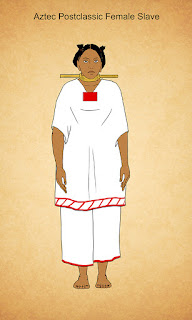Aztecs clothing varied from simple to elaborate depending on the following factors:
- Class
- Wealth
- Status
Draped Items
Men commonly wore loincloths known as Maxtatl. This clothing came in two styles wrapped around the hips and through the legs. All men of all classes wore loincloths. They would reflect wealth and status through design motifs. For ceremonial purposes some loincloths would have loose cloth in front and back of the wearer. Musicians, Warriors and Cargadors would wear square pieces of cloth tied to the right hip. Capes were also the most important status symbol.
The fabric worn was an identification of the identity and class of the wearer. Commoners wore materials called maguey, yucca or palm fiber garments. The higher classes wore cotton clothing with decoration.
Cloak would also differ in appearance depending on the wearer's rank. Soldiers could only wear simple cloaks with no embroidery. The length would only be able to reach as far as below the knee. If it reached below the ankle in length it was punishable by death.
Women wore skirts known as Cuietl. That could either be very basic in style or decorated with rich embroidery. The embroidered skirts would be made of thin cotton with stripped edges. The coloured edges were created by combining finespun, dyed rabbit hair and feathers.
Slip on Garments
These garments were stitched together at the top of the garment and then draped over the shoulders covering front and back of the wearer. Women wore these garments known as Qechquemitl during ceremonial events.
Open Sewn Garments
Aztec warriors wore a short padded, quilted jacket-like cotton armour known as Ichahuipilli. The shirt was made with fluffed up cotton covered in cloth and stitched in a leather border with leather thongs.
A male sleeve-less jacket known as Xicolli was used in rituals.
Closed Sewn Garments
This style came in two different forms. They were known as Ichahuipilli as well. The first style was undecorated and sleeveless that reached to the top of the wearers thighs. The second style was a pull-on sleeveless garment that reached mid-thigh and was decorated.
Another garment that rested below the hip and was also sleeveless was the Huipilli. This was the basic garment worn by all classes of women. Again with the more decorated designs belonging to the higher ranks. These garments were usually worn with skirts.
Limb Encasing Garments
These garments were known as Tlahuiztli and were worn by men. They were used as military attire. They encased the mans body and in some cases even the head. They also consisted of a feather-covered fabric.
- Class
- Wealth
- Status
Draped Items
Men commonly wore loincloths known as Maxtatl. This clothing came in two styles wrapped around the hips and through the legs. All men of all classes wore loincloths. They would reflect wealth and status through design motifs. For ceremonial purposes some loincloths would have loose cloth in front and back of the wearer. Musicians, Warriors and Cargadors would wear square pieces of cloth tied to the right hip. Capes were also the most important status symbol.
The fabric worn was an identification of the identity and class of the wearer. Commoners wore materials called maguey, yucca or palm fiber garments. The higher classes wore cotton clothing with decoration.
Cloak would also differ in appearance depending on the wearer's rank. Soldiers could only wear simple cloaks with no embroidery. The length would only be able to reach as far as below the knee. If it reached below the ankle in length it was punishable by death.
Women wore skirts known as Cuietl. That could either be very basic in style or decorated with rich embroidery. The embroidered skirts would be made of thin cotton with stripped edges. The coloured edges were created by combining finespun, dyed rabbit hair and feathers.
Slip on Garments
These garments were stitched together at the top of the garment and then draped over the shoulders covering front and back of the wearer. Women wore these garments known as Qechquemitl during ceremonial events.
Open Sewn Garments
Aztec warriors wore a short padded, quilted jacket-like cotton armour known as Ichahuipilli. The shirt was made with fluffed up cotton covered in cloth and stitched in a leather border with leather thongs.
A male sleeve-less jacket known as Xicolli was used in rituals.
Closed Sewn Garments
This style came in two different forms. They were known as Ichahuipilli as well. The first style was undecorated and sleeveless that reached to the top of the wearers thighs. The second style was a pull-on sleeveless garment that reached mid-thigh and was decorated.
Another garment that rested below the hip and was also sleeveless was the Huipilli. This was the basic garment worn by all classes of women. Again with the more decorated designs belonging to the higher ranks. These garments were usually worn with skirts.
Limb Encasing Garments
These garments were known as Tlahuiztli and were worn by men. They were used as military attire. They encased the mans body and in some cases even the head. They also consisted of a feather-covered fabric.










No comments:
Post a Comment